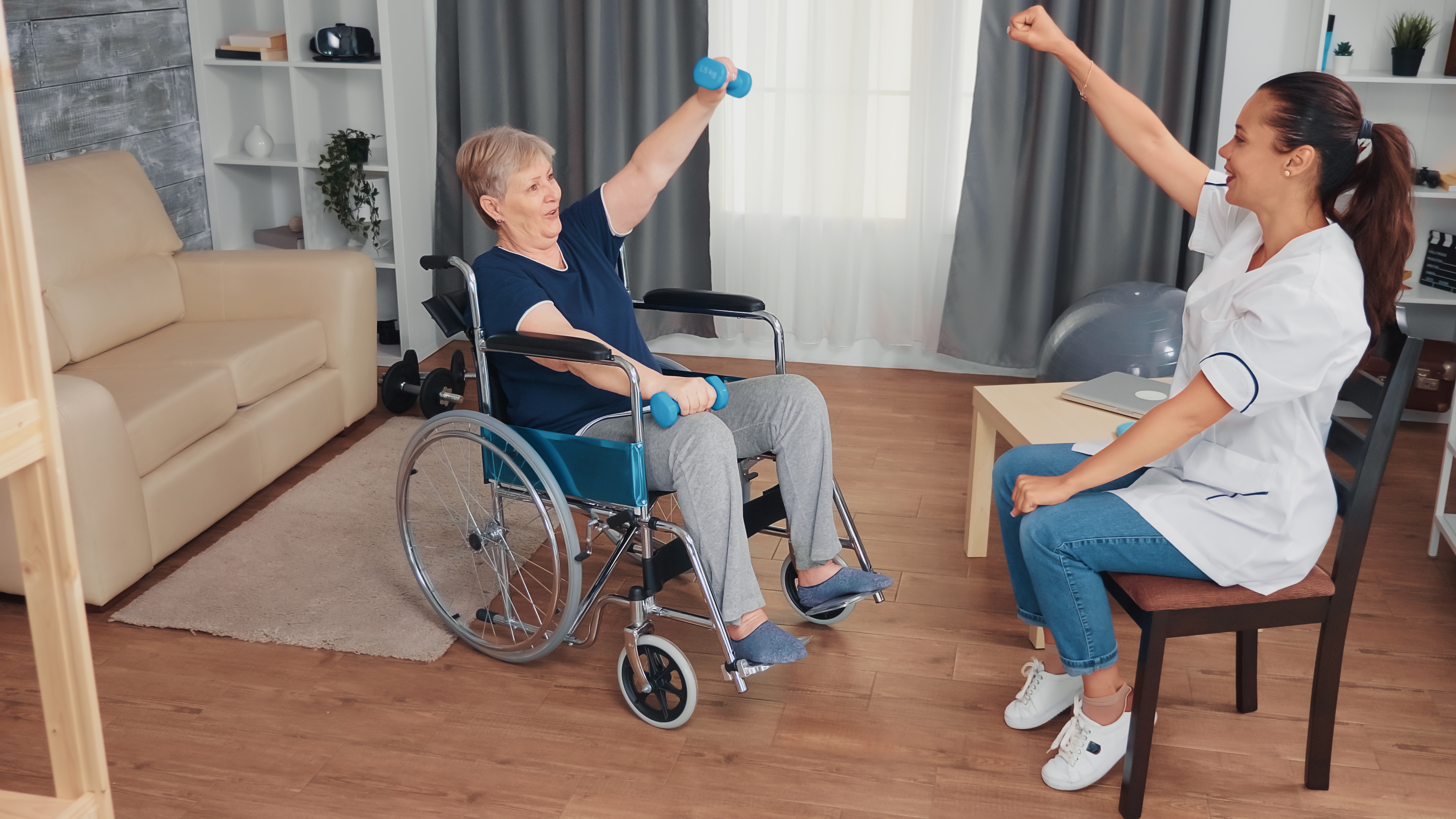Crafting Happiness With Nursing Home Activities Ideas

Engaging activities play a crucial role in the overall well-being of nursing home residents. As individuals age and move into long-term care facilities, maintaining their physical, mental, and emotional health becomes even more important. Nursing homes are responsible for providing an environment that promotes a high quality of life for their residents, and offering a variety of stimulating activities is an essential part of achieving this goal. Below we cover a variety of nursing home activity ideas that you can implement in your nursing home facility.
Benefits of Nursing Home Activities
Physical Benefits
Improving mobility and overall health enhancement are crucial aspects when planning activities for residents in nursing homes. These fun activities play a significant role in maintaining not only physical but also mental well-being. By focusing on these areas, nursing home staff can help residents lead more fulfilling lives and experience an improved quality of life.
One way to improve mobility is by incorporating regular exercise sessions into the daily routine. These exercises should be tailored to the resident’s abilities and may include stretching, strength training, and cardiovascular activities. Regular exercise can help improve muscle strength and flexibility, increase balance and coordination, and enhance overall physical function.
In addition to exercise, activities such as walking groups or outdoor outings can also promote physical well-being. Fresh air and sunlight have been shown to have numerous health benefits, including boosting mood, improving sleep quality, and increasing vitamin D levels. Taking residents on walks or outings to nearby parks or gardens can provide them with opportunities for physical activity while enjoying nature.
Mental Benefits
Engaging in activities that provide cognitive stimulation is essential for maintaining mental health and preventing cognitive decline in nursing home residents. These mental stimulation activities can include puzzles, brain games, trivia quizzes, reading groups, and craft activities. These types of activities help keep the residents’ minds active and challenged, which can improve memory, attention, and cognitive function.
Social interaction is another crucial aspect of nursing home activities. Many residents may experience feelings of loneliness and isolation, so providing opportunities for socialization can greatly benefit their mental well-being. Group activities such as bingo nights, movie screenings, or discussion groups allow residents to connect with others, form meaningful relationships, and combat feelings of loneliness. Creating a sense of community and belonging is important for overall mental health.
Planning Considerations for Nursing Home Activities

When planning activities for nursing home residents, it is important to take into consideration their preferences and interests. Each resident has unique likes and dislikes, so it is crucial to gather information about their hobbies, pastimes, and personal history. This can be done through surveys or by engaging in conversations with the residents themselves or their family members.
Surveys and feedback are an effective way to gather information about resident preferences. By asking residents what activities they enjoy or would like to participate in, nursing home staff can tailor activity programs to meet their needs and interests. This not only increases the likelihood of engagement and participation but also enhances overall satisfaction and enjoyment.
In addition to gathering preferences, it is important to create individualized activity plans for residents. This takes into consideration their physical limitations and health conditions. Not all residents may be able to participate in the same activities, so it is important to adapt and modify activities based on individual needs.
Physical Limitation Considerations
For residents with physical limitations, adaptive activities can be implemented. This may include chair exercises, seated yoga or stretching, or modified sports games. These activities allow residents with limited mobility to still engage in physical activity and experience the benefits of movement.
To cater to residents with specific health concerns, specialized activity plans can be created. For example, for residents with arthritis or joint pain, low-impact activities such as water aerobics or gentle stretching programs may be beneficial. For residents with dementia, memory games or reminiscing activities can help stimulate their cognitive abilities and promote mental well-being.
Time and Resources Available
When planning nursing home activities, it is also important to consider the time and resources available. It is important to have a schedule in place that ensures activities are spread out throughout the day and week, allowing residents to have variety and options. Additionally, having enough staff members or volunteers available to facilitate and supervise activities is crucial.
Welcoming Environment
Creating a welcoming and comfortable environment for activities is also important. Ensuring that the space is accessible, well-lit, and comfortable can greatly enhance the residents’ experience. This may include arranging furniture in a way that promotes social interaction, providing comfortable seating options, and creating a visually appealing environment.
Evaluate Activities
Lastly, it is important to regularly evaluate and assess the effectiveness of the activities being offered. Collecting feedback from residents and staff can provide valuable insights into what activities are working well and what may need to be adjusted or changed. This continuous assessment and feedback loop allows for ongoing improvement and ensures that the activity programs are meeting the needs and preferences of the residents.
Creative Activity Ideas for Nursing Home Residents

When planning activities for nursing home residents, it is important to consider their physical, mental, and social well-being. Creative activities can provide a sense of accomplishment and joy, while also stimulating the mind and promoting social interaction. Here are some creative activity ideas that can be organized in nursing homes.
Physical Activities
- Chair Yoga and Gentle Exercises: Engage residents in chair yoga or gentle exercises that can be done while seated. This allows residents with limited mobility to still engage in physical activity and experience the benefits of movement.
- Outdoor Gardening: Create a small garden space where residents can participate in gardening activities. This can involve planting flowers or vegetables, watering plants, or simply enjoying the outdoors.
Mental Stimulating Activities
- Puzzle Games: Provide residents with puzzles, such as jigsaw puzzles or crossword puzzles. These activities can help stimulate cognitive abilities and promote mental well-being.
- Arts and Crafts: Organize arts and crafts sessions where residents can create artwork, make collages, or engage in other creative projects. This can be a therapeutic activity that allows residents to express themselves and explore their creativity.
Social and Recreational Activities
- Group Outings: Plan group outings to local attractions, such as museums, parks, or theaters. This allows residents to socialize with each other and experience new environments outside of the nursing home.
- Movie Nights: Organize movie nights where residents can gather to watch a film. Provide popcorn and drinks to create a cinema-like atmosphere and encourage discussions about the movie afterward.
Remember to tailor activities to the interests and abilities of residents. It is important to offer a variety of options so that residents can choose activities that they enjoy and feel comfortable participating in.
Implementation Strategies

Collaborate with staff and family
Involve nursing home staff and family members in the activity planning process. They can provide valuable insights, suggestions, and support in implementing the activities. Collaboration with staff is also important for ensuring that the activities align with the residents’ care plans and that any necessary accommodations or modifications are made.
Train activity coordinators
Provide training and support to activity directors/coordinators to ensure they have the knowledge, skills, and resources needed to effectively plan and implement creative activities. This may include training on how to adapt activities for residents with different abilities or cognitive impairments.
Regular program assessment
Continuously assess the effectiveness of the activity program by collecting feedback from residents, staff, and family members. This can be done through surveys, focus groups, or individual interviews. Use this feedback to make improvements and adjustments to the program as needed.
Overcoming Challenges in Nursing Home Activity Planning
Planning activities for nursing home residents can be a rewarding and fulfilling experience. However, it also comes with its fair share of challenges. Here are some strategies to overcome these challenges and create meaningful experiences for the residents:
Addressing Resistance
One common challenge is resistance from some residents who may not initially show interest in participating in activities. To address this, it is important to take a person-centered approach and understand each resident’s individual preferences and needs. Take the time to build rapport with residents and establish trust, so they feel comfortable participating in activities. Offer a variety of options and adapt activities to cater to different interests and abilities. Provide incentives or rewards for participation, such as small prizes or recognition, to encourage engagement.
Managing Diverse Health Levels
Residents in nursing homes often have varying health levels, including physical limitations and cognitive impairments. This can make it challenging to plan activities that are inclusive and enjoyable for all residents. To overcome this challenge, consider the following strategies:
- Adapt activities: Modify activities to accommodate different abilities and limitations. For example, if a resident has limited mobility, offer seated exercises or modified versions of games. If a resident has cognitive impairments, focus on activities that stimulate their senses or memory, such as music therapy or reminiscence activities.
- Offer a range of options: Provide a variety of activities that cater to different interests and abilities. This allows residents to choose the activities they feel most comfortable participating in and increases the chances of engagement.
- Collaborate with healthcare professionals: Consult with healthcare professionals, such as physical therapists or occupational therapists, to better understand residents’ specific health needs and limitations. They can guide appropriate activities and modifications that may be needed.
Budget Considerations
Budget constraints can limit the resources available for activities in nursing homes. However, there are still ways to create meaningful experiences within a limited budget. Here are some strategies:
- Seek community partnerships: Reach out to local organizations, clubs, or volunteers who may be willing to donate their time or resources for activities. This can include musicians, artists, or community groups that specialize in senior engagement. They may be able to provide entertainment or lead workshops at no cost.
- Utilize existing resources: Use the facilities and materials already available in the nursing home. For example, utilize outdoor spaces for gardening activities or use art supplies that are already on hand for art therapy sessions.
- Get creative with low-cost activities: Look for inexpensive or DIY options for activities. This can include things like movie nights with popcorn, trivia games using homemade question cards, or craft projects using recycled materials.
- Prioritize meaningful experiences: Focus on quality rather than quantity when it comes to planning activities. Instead of trying to have a packed schedule of activities every day, prioritize meaningful experiences that truly enhance the residents’ well-being and quality of life. This could include personalized outings or trips, one-on-one interactions with volunteers or staff members, or activities promoting socialization and connection among residents.
In conclusion, planning activities for nursing home residents require a person-centered approach, adaptation to diverse health levels, and creative solutions for budget constraints. By taking the time to understand each resident’s preferences and needs, offering a variety of options, and adapting activities accordingly, you can increase engagement and participation.
Final Thoughts

The significance of nursing home activities cannot be overstated, as they play a pivotal role in enhancing the overall well-being of residents. Engaging in purposeful, stimulating activities not only contributes to physical health but also fosters mental acuity and emotional fulfillment. As we’ve explored the numerous benefits, from improved mobility to heightened cognitive function and emotional connection, it becomes evident that a well-crafted activity program is an essential component of quality care in nursing homes.
Therefore, there is a pressing need for healthcare facilities, policymakers, and stakeholders to recognize the importance of prioritizing and investing in such activities. By allocating resources and attention to developing robust activity programs, we can create environments that promote a higher quality of life for nursing home residents. This not only aligns with ethical standards of care but also fulfills a moral obligation to provide dignity, joy, and a sense of purpose to those who have contributed so much to our communities.
As we move forward, let us champion a culture that places the well-being of nursing home residents at the forefront. Investing in engaging activities is an investment in the residents’ dignity, happiness, and sense of belonging. By fostering an environment that values and promotes these activities, we can ensure that nursing home residents lead fulfilling lives during their later years. The call to action is clear – prioritize and invest in activities that enhance the lives of our elders, turning nursing homes into vibrant communities where residents can thrive in every aspect of their well-being.
